|
|
|
Sort Order |
|
|
|
Items / Page
|
|
|
|
|
|
|
| Srl | Item |
| 1 |
ID:
139758


|
|
|
|
|
| Summary/Abstract |
If there is any single proof of the transformation of US-Indian relations since 2001, burgeoning defence ties would stand out as ‘Exhibit A.’ Since the trying moments after the 1998 Indian nuclear tests—when Indian strategic entities became targets of US sanctions, when Indian weapons systems of US origin lay non-operational because spare parts were denied, and when US-Indian defence trade was minuscule — the flood of interactions that have now become commonplace mark defence cooperation as the cornerstone of the steadily strengthening bilateral relationship.
|
|
|
|
|
|
|
|
|
|
|
|
|
|
|
|
| 2 |
ID:
148055
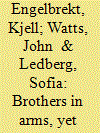

|
|
|
|
|
| Summary/Abstract |
2014–2015 were years of turmoil for strategic relations, with Sino-Russian relations emerging as a particularly interesting set of ties to observe. This article asks whether recurrent Sino-Russian exhortations of friendship are mirrored by their strategic alignment in the defence and security realm, half a century after the end of the Sino-Soviet pact during the communist era. We examine the arms trade between the two countries and with regional partners, but also the recent pattern of bilateral and multilateral military exercises, as a combined test of the security and defence relationship. We are able to show that the image of friendship that both Moscow and Beijing like to promote, while apparent at the UN Security Council and within the BRICS group, remains constrained by rivalry in high-tech segments of the arms industry and by lingering concerns about the prospects of peer interference in their shared regional vicinity.
|
|
|
|
|
|
|
|
|
|
|
|
|
|
|
|
| 3 |
ID:
182032
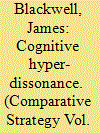

|
|
|
|
|
| Summary/Abstract |
Military Exercises provide practice in the art of war; they also send messages of political resolve. The Cold War record of signaling nuclear intent through military exercises reveals that most of the time both sender and receiver misperceive each other’s messages. Today’s nuclear armed states must design their exercise programs to communicate the messages they want others to understand.
|
|
|
|
|
|
|
|
|
|
|
|
|
|
|
|
| 4 |
ID:
175119
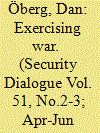

|
|
|
|
|
| Summary/Abstract |
This article analyzes how contemporary military training and exercises shape and reify specific modalities of war. Historically, military training has shifted from being individual- and experience-oriented, towards becoming modelled into exercise environments and practices. Drawing on semi-structured interviews with military officers, exercise controllers, and war-game designers, the article distinguishes between tactical training, characterized by military functions embodied through weapon platforms in a demarcated battlespace, and operational training, characterized by administrative and organizational processes embodied through self-referential staff routines. As military exercises integrate the tactical and operational dimensions into a model for warfare, they serve as blueprints for today’s battles at the same time as they perpetuate a martial viewpoint of the world. As a result, preparations for potential future conflicts constitute a fertile ground for apprehending the becoming of war.
|
|
|
|
|
|
|
|
|
|
|
|
|
|
|
|
| 5 |
ID:
106192
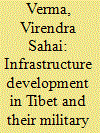

|
|
|
| 6 |
ID:
139171
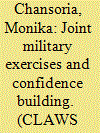

|
|
|
|
|
| Summary/Abstract |
The broad generic characterisation of Confidence-Building Measures (CBMs) is of them being a set of unilateral, bilateral, or multilateral procedural actions that primarily are put in place to decrease military tensions between state actors (nation-states) before, during or after actual conflict. States with security-related differences that could potentially lead to conflict should encourage channels to communicate regularly through consultative mechanisms with transparency measures that foster greater candidness of military cooperation. These could include pre-notification requirements, military exercises and related operating procedures. In today’s conflict-ridden world, CBMs serve as an effective tool to make a breakthrough towards the larger goal of conflict resolution. The aim of CBMs is to help build a working trust by addressing the more amenable issues by means of substantive negotiations, which, in turn, could potentially allow parties to address the more contentious aspects of a conflict.1 CBMs, thus, are not necessarily an end in themselves, but rather useful steps to negotiate and implement processes that could become bridges to reduce conflict situations between states.
|
|
|
|
|
|
|
|
|
|
|
|
|
|
|
|
| 7 |
ID:
188350
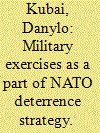

|
|
|
|
|
| Summary/Abstract |
The main aim of the article is to contribute to the better understanding of the role of military exercises for the deterrence strategy of NATO, in particular by proving the premise that military exercise is one of the most effective instrument of the military capabilities demonstration and political persuasion. Against the backdrop of the Russian revisionism and its ongoing aggression against Ukraine, NATO and its member states have substantially reinforced their deterrence capabilities. An increased number of military exercises, their geography and scale are intended to demonstrate the Alliance’s capacity and commitment to respond to potential aggression.
|
|
|
|
|
|
|
|
|
|
|
|
|
|
|
|
| 8 |
ID:
154486
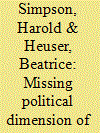

|
|
|
|
|
| Summary/Abstract |
Military exercises are rarely straightforward in either intention or outcome. Official policy and governance about exercises have not kept up with the complexity of the current national and international contexts. In addition to collective training, exercises are now used for a wide variety of purposes, such as fostering alliance cohesion and defence diplomacy. In this article, Beatrice Heuser and Harold Simpson argue that the diverse effects and outcomes of exercises merit further investigation, and future guidance for British practitioners will reflect this.
|
|
|
|
|
|
|
|
|
|
|
|
|
|
|
|
| 9 |
ID:
179965
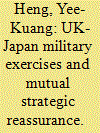

|
|
|
|
|
| Summary/Abstract |
The United Kingdom (UK) and Japan have conducted unprecedented military exercises as each other’s closest security partners in Asia and Europe, respectively. Despite publicly avowed closeness, these military exercises were not predicated on formal alliance commitments or deterrence of common adversaries underpinned by shared threat perceptions. Addressing this puzzle, a hitherto-overlooked perspective of mutual strategic reassurance for trusted partners is proposed here. This paper derives hypotheses from existing – but relatively under-developed – literatures on military exercises and reassurances that locate the drivers of reassurance in the needs and weaknesses of the other. What stems from this starting premise is an importance placed on high-level diplomacy and adjusting military deployments to allay each other’s strategic concerns. These hypotheses are tested by presenting original interview data supplemented with discourse analysis of both primary and secondary sources. The findings suggest that effusive diplomatic language vowing politico-strategic support for each other, reinforced by ground-breaking military exercises mutually reassured UK concerns about retaining post-Brexit global standing and Japan’s apprehension over its dire geo-strategic context. While not quite deterrence or alliance, these military exercises enabled the UK and Japan to transform their predominantly trade-based relationship into a more defence-oriented one.
|
|
|
|
|
|
|
|
|
|
|
|
|
|
|
|
| 10 |
ID:
190099
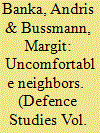

|
|
|
|
|
| Summary/Abstract |
To what ends do allies employ military exercises? In order to further our understanding regarding the logic and utility of military drills, this paper focuses on NATO’s eastern flank. Specifically, with the help of newly compiled data, we tracked two decades of exercises in the Baltic states. Our analysis speaks to the fact that the size, tempo, and character of military training events in this region have manifestly changed. In the early 2000s, military drills were primarily conceived as a mechanism to modernize Baltic armed forces and ensure their adequacy to NATO membership standards. The 2014 Crimea crises, however, dealt a serious blow to the regional order. This event was the primary driver behind a considerable spike in the overall exercise numbers. At the same time, we observe that it was not only a mere quantitative shift that transpired. From parachute drops into remote areas, rehearsals of river crossings to moving of combat power via narrow land corridors, the staging of military exercises after 2014 were overhauled into events that accentuated NATO’s reinforcement capabilities. In this context, military exercises can be seen as a crucial element to credibly signal capacity and resolve within the concept of deterrence by reinforcement.
|
|
|
|
|
|
|
|
|
|
|
|
|
|
|
|
|
|
|
|
|